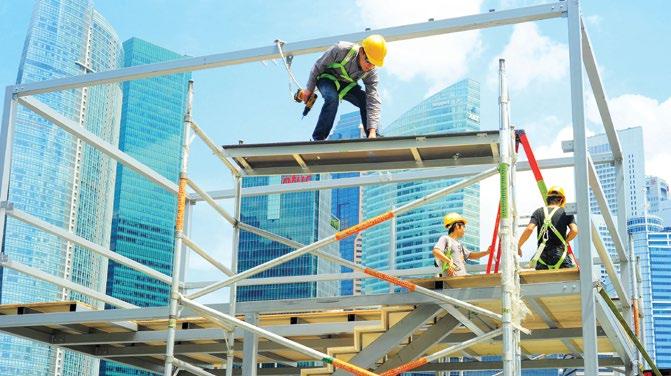
5 minute read
What is the Progressive Wage Model and is it better than a minimum wage?
from Global-is-Asian 2020 issue
by Lee Kuan Yew School of Public Policy, National University of Singapore
Featured Faculty: Terence Ho Associate Professor in Practice, Lee Kuan Yew School of Public Policy
The issue of a minimum wage has been thrust into the spotlight recently in Singapore, as the country’s first parliamentary opposition pushed for what it described as “a greater injection of compassion and thoughtfulness”.
In the opening session of parliament, Workers’ Party Member of Parliament Jamus Lim argued for a minimum wage, saying that it would be achievable because Singaporeans have indicated they might be willing to pay more for essential services and the impact on the workforce would likely be very limited.
The government disagrees, and plans to stick with the Progressive Wage Model (PWM) it has implemented over the past decade. Gan Siow Huang, the Minister of State for Manpower, argued that in the current economic climate, an across-the-board minimum wage could cost jobs.
“I think many of our lower paid workers would lose their jobs. And from low wage they become no wage,” she told parliament.
But the government and the opposition are not light years apart on this issue. Both agree on the need to increase wages for Singapore’s lowest paid workers, even if they disagree on the methods for doing so.
How does the PWM differ from minimum wage?
There are a few key differences between the government’s PWM and a SGD$1300 a month minimum wage, as laid out in the Workers’ Party manifesto. Perhaps the most obvious is the scope. The PWM is implemented in a few sectors, while a minimum wage would apply to all businesses across the board.
The second is the differences in quantum. A minimum wage of SGD$1300 in take-home pay appears higher than the PWM floor wages in Cleaning and Security, after factoring in employee Central Provident Fund contributions.
But the PWM is not the government’s only policy to help Singapore’s lowest-paid workers, according to Terence Ho, Associate Professor in Practice at the Lee Kuan Yew School of Public Policy.
“The progressive wage is not the only intervention the government has to tackle the issue of low wages,” he said.
The Workfare Income Supplement (WIS) Scheme and Silver Support (SS) Scheme, for example, disburse additional funds to low-wage workers, particularly seniors. Factoring in these additional benefits, a worker on PWM wages may receive an amount comparable with a take-home pay of SGD$1,300.
But perhaps the most significant difference is the PWM’s wage ladder. It is effectively a sectoral minimum wage, set through a tripartite negotiation process involving government, union and other industry representatives. In addition to setting a minimum wage, they also set wage rungs, giving workers a way to seek out a pay increase by improving their skills.
“In a sense, the PWM is really a sectoral minimum wage. But it could also be considered a minimum wage plus, because it specifies an income and skills ladder that goes beyond the flat minimum,” said Professor Ho.
Another advantage to a Progressive Wage Model, added Professor Ho, is that it allows for customisation to the needs of a sector. For example, there will be a higher wage for lift maintenance workers, who tend to be skilled workers.
The government initially intervened in sectors which had seen declining wages before the PWM took effect, notably the cleaning, security and landscaping sectors. Senior Minister Tharman Shanmugaratnam told parliament that this has had an impact.
“We’ve achieved significant progress in the last 10 years, and in the last five years, and we think we should go further,” he said. Cleaning, security and landscaping workers have seen cumulative wage growth of around 30 percent in the last five years, compared to the median of 21 percent.
The government is now pushing industries to adopt the PWM voluntarily. A new PWM Mark will let consumers know that a business is part of a PWM agreement, allowing them to vote with their wallet for higher wages.


Associate Professor in Practice Terence Ho
Will Singapore adopt a minimum wage?
The Workers’ Party estimates that under the status quo 100,000 people in Singapore would make less than their nominated minimum wage of SGD$1,300.
But for the moment, the government seems unlikely to support a minimum wage. Singapore’s unemployment rate is at its highest in a decade, and the government is worried that introducing a new minimum might hurt the very people it’s supposed to help. In his address to parliament, Dr. Lim also acknowledged that the time “may not be ideal” for a minimum wage.

high minimum across the economy might particularly hurt older workers and those with lower skills,” echoed Professor Ho.
Economist Milton Friedman famously argued that “insofar as minimum-wage laws have any effect at all, their effect is clearly to increase poverty.” The logic is that if labour is too expensive, then businesses will find a way to employ fewer workers, either through automation or maybe just going without.
But businesses can also make cuts elsewhere to accommodate the higher wages or they can pass the cost onto their customers through higher prices. And in fact, many economists argue that the relationship between increased unemployment and the minimum wage isn’t nearly so clear cut, or that the improved welfare of those who get pay raises outweighs the possible additional job losses.
While most countries have some form of minimum wage, Singapore isn’t the only developed country that doesn’t. Denmark, Italy, Austria, Finland, Sweden and Iceland have no mandated minimum wage. Pay rates in those countries, which are high by global standards, are instead negotiated through unions.

Others, like Australia, have something of a hybrid system. There is a minimum wage, but often “award” rates above the minimum are set through industry agreements. Professor Ho thinks that Singapore’s unusual labour market, which includes a large number of foreign workers, makes it a unique case. For the moment, he expects the government to focus on expanding voluntary PWM agreements.
“I think the government tries to keep an open mind on all issues now. They’re saying, “whether it’s minimum wage or unemployment insurance, we never say never” but clearly the intent is to stick with the PWM model for now,” he said.











